IF you want to improve your shooting, where do you start? Where do you concentrate? Over the years, I have formed a process of study for those interested in improving their shooting. I have been studying and refining my own take on marksmanship for several years and I feel confident in sharing a solidified shooting pathway to help shooters focus on enhancing skill. I identified three areas of study which are all complimentary and they continue to remain my areas of study. Focusing on any one of these areas will make you a better shooter, but to become the best Rifleman you can be, it will be important to study each to round out your skill set. The first area of study is the most obvious. Do you know how to shoot a rifle?
The Rifleman:
The most basic of marksmanship goals most shooters seek to accomplish is basic positional shooting and mastery of sight alignment. We won’t dwell too much on this topic, but it starts the foundation of accurate rifle fire. It is important to understand the ergonomic relationship between the rifleman and the rifle, and the manipulation of the rifle in both conventional and unconventional positions, as well as expedient position shooting, are encompassed under this topic.
These skills are the absolute basics. If they study nothing else, the study of prone, kneeling, standing, sight picture, trigger control, and expedient shooting (such as barrier support, and unconventional positions) will form adequate level of competency within the rifleman’s zero range of 100-200 yards.
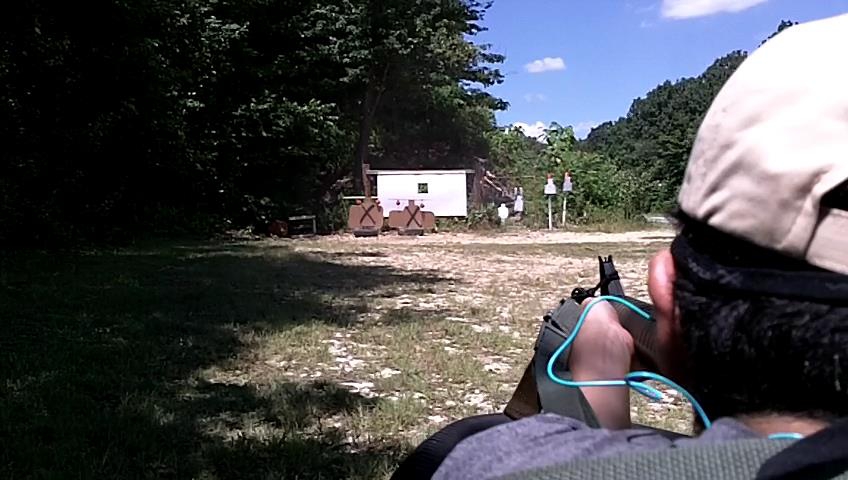
Me Circa I Don’t Know When. Basic skills practiced under duress of time will lead to better shooting. A new rifleman should compete with their basic gear as often as possible. The gear I had in this series was laughable, but I was there sweating and shooting and manipulating.
(If you want an excellent resource online to get started with positions, please visit AZRifleman and his marksmanship series located HERE.)
It should be understood that the slung up rifleman is both a foundation and yet at the same time a legacy. While I encourage the use of the sling in the formation of positional shooting, it is truly a legacy item that bears little practical application. Like irons, its use is becoming less relevant with every passing year. If in a time crunch, bypassing legacy techniques and equipment (such as shooting jackets, the aforementioned sling, and dare I say iron sights) for modern equipment and theory (such as magazine monopod, red dot or optics, shooting with armor) will hasten the shooter’s capability and relevance.
A new shooter with a coach, a 100 yard range, equipped with a basic rifle, and “standard issue” ammunition such as XM193 will be capable of solid shooting with excellent capabilities out to the zero range or just past it within a few sessions. Let’s call the end of this basic range 250 ish yards. Past that, without additional training in ballistics, the shooter capabilities begin to slowly degrade. How do we rectify that?
External Ballistics:
This would be the next area of study. Without studying bullet drop, windage correction, a rifleman’s hit percentage will drop out to intermediate distances. Inside of the zero range, it would take a harsh wind to push the 5.56 off target. Past that range, it becomes necessary to apply correction to both windage and elevation.
Introducing drop tables and wind tables, and explaining the concepts of ballistic coefficient and how that relates to wind and drop are topics which will enhance a rifleman’s capability past the zero range and into intermediate distances. With modern glass, and equipped with a drop and wind table, the shooter well versed in the basic marksmanship fundamentals will be able to easily integrate the corrections into their optic and have a good chance at success at KD ranges.
Even red dots can execute holdovers though I would argue that they will be limited to around 400 yards for repeatable holdovers (see my article from TTAG a few years ago HERE for red dot holds).
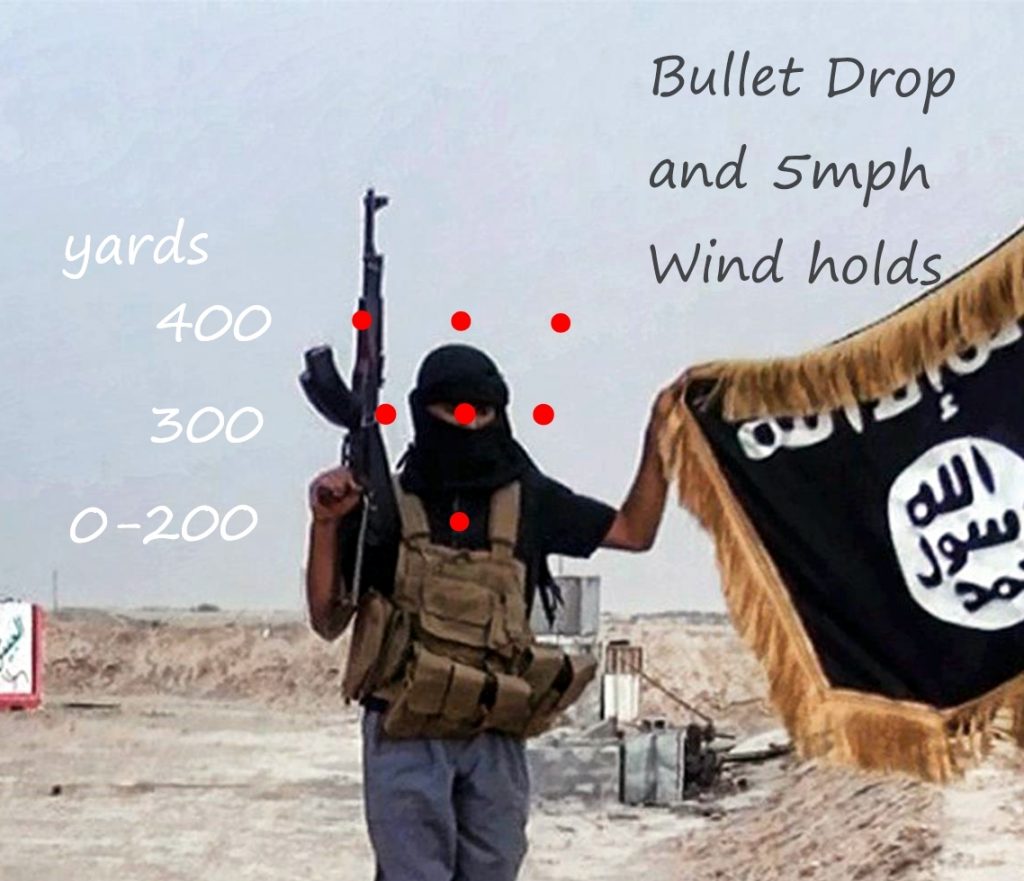
Red dot holds for a 200 yard zero with wind deflection. A human anatomy based BDC AKA “Hold Over”.
It is important to mention that experience with KD ranges will only take the rifleman so far in a low confidence environment. While easily integrated with known ranges and good wind calls, corrections become more difficult in true field conditions where time, pressure, and unknown ranges combine to decrease hit percentages.
Because of the difficulty of a field shot, a rifleman should study deeper into external ballistics once past the introductory KD range examples. The next logical point of discussion should be how to mitigate error in low confidence environments. Can we? What methods are available to the rifleman when time is of the essence and proper estimation are not possible? MPBR.
Maximum point blank range must be discussed. In order to hit a target at unknown range, and to do so with wind calls that are imperfect, we must incorporate a smart zero with a bullet choice that is complimentary to our goals.
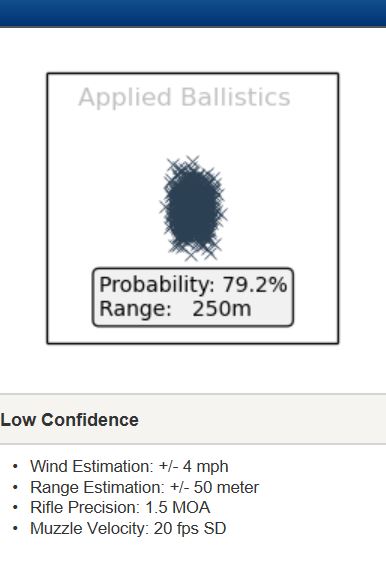
A 75 grain Hornady HPBT with a 100 meter zero in a low confidence environment. Note the vertical dispersion and compare to the result below.
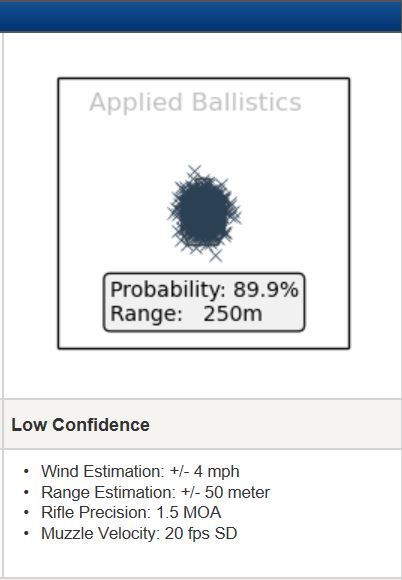
The same 75 Grain HPBT with a maximum point blank range zero (233 meters) which is a rise and fall of +/- 3 inches. The change in zero in a low confidence environment results in nearly 10% increase in a chance of a hit at an unknown range. While we know the range in the example, the target in the field would be considered to be at an unknown range. IF you have only seconds to shoot, which zero do you want?
The above example illustrates why a zero makes so much difference. If the rifle precision and ammunition precision were increased, the hit percentages would each climb a few more points. This is why ammo is so important. Let’s touch on that.
Not only do we want vertical error to be mitigated with a smart zero, but we also want accuracy maximized to make sure the bullet stays inside our MPBR. Inaccuracy may drift the bullet higher or lower than we want effectively changing our MPBR. Ergo, we want the highest BC bullet we can shoot down the pipe as fast as we possibly can. Choosing a higher BC projectile will also soak up some wind error, allowing the wind to act on the bullet less and ensure a few percentage points of hit probability. Maximum point blank range coupled with smart bullet selection is the vehicle with which the rifleman will use to reduce error in a low confidence environment and should absolutely be studied.

The above example illustrates why an accurate rifle and bullet matters. Accurate projectiles wont drift outside of your MPBR. The heavier bullets also resist wind drift better.
The proper zero will depend on velocity and projectile choice, so MPBR is unique to rifle, projectile, and even the rifleman… as some shooters will consider +/- 3 inches comfortable while some will consider +/- 2 inches optimal.
For additional reading on MPBR go HERE.
In summation, we can use drop tables to dial into exact ranges, but often we are under pressure of time and need to estimate ranges on the fly. It is important that we understand the concept of MPBR when shooting under duress. If you have time to properly range and estimate a targets distance, and call wind, utilize drop tables to ensure a higher probability of a hit. Until then, master your trajectory as it relates to your MPBR.
A rifleman who has mastered the basics to this point is a competent shooter and has the tools necessary to be a devastating rifleman. When the target increases in distance, there is another area of study that becomes vital to round out the rifleman’s capability. Past the maximum point blank range, we run into new and unique problems.
Environment:
Your environment is another area of mastery. This entails wind calls and distance estimation using experience and /or tools. Most shots will take place within your maximum point blank range. As we increase the distance the environment’s effects are compounded. We have to learn exacting estimates of both distance and wind in order to increase hit probability at a distance. Everything past our MPBR really puts us at diminishing returns with a 5.56 rifle, but hits out to 700-800 yards are possible.
Since the rifleman has both learned proper shooting form, and has chosen a high accuracy, high BC projectile launched as fast as possible from an accurate platform, he or she will be better qualified to shoot at extended distances with those two boxes checked. The next hurdle will be overcoming the wind and proper estimation of target distance.
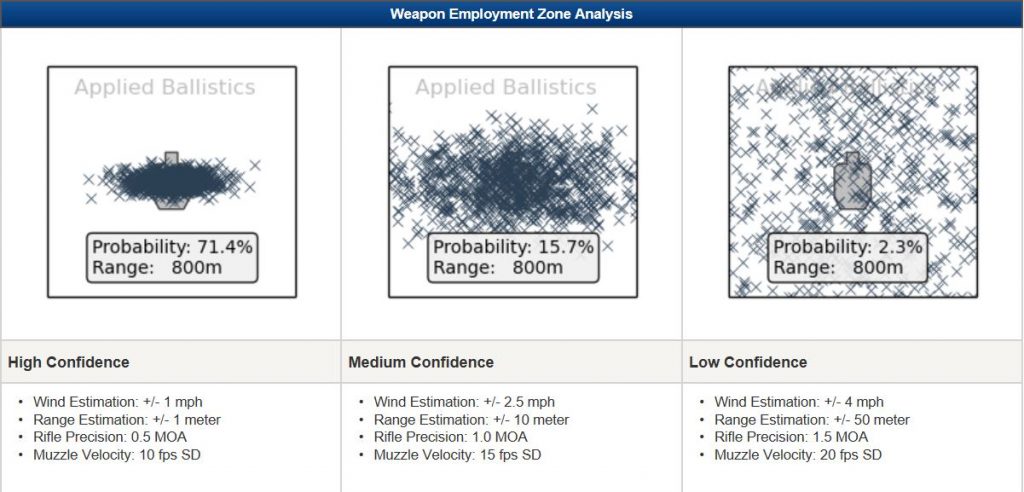
While not a direct comparison since the rifle precision changes from example to example, you can see why a rifleman realizes shooting is a game of moneyball. Hit percentages are directly tied to rifle precision, accurate ranging, accurate wind calls, and not to mention a skilled shooter. Accurate ammo / rifle, accurate ranging, and precise wind estimation will rule the day at increased distances.
Bryan Litz has illustrated to us thorough his WEZ software that hit probability is tied closely into accurate wind and range estimation at extended ranges. When pushing 5.56 to 700-800-900 yards we must estimate the range to the yard and wind to the mph if possible. Needless to say that requires special tools to measure our environment. A laser range finder and a kestrel are two tools that will increase our hit probability many times over. Mil Dots will get us close for ranging, but they are far from exact. Reading the wind with sand, your face, and the trees is better than a blind guess if your good, but it will be far from exact.
Eliminating error at extended ranges is essential. From mk1 eyeball and beard wind whip, to mil rad / ranging reticles, to laser range finders and kestrals, they all have value… but I will let you take a guess as to which tools will ensure the highest probability of a hit.
Hint: it’s the modern technology.
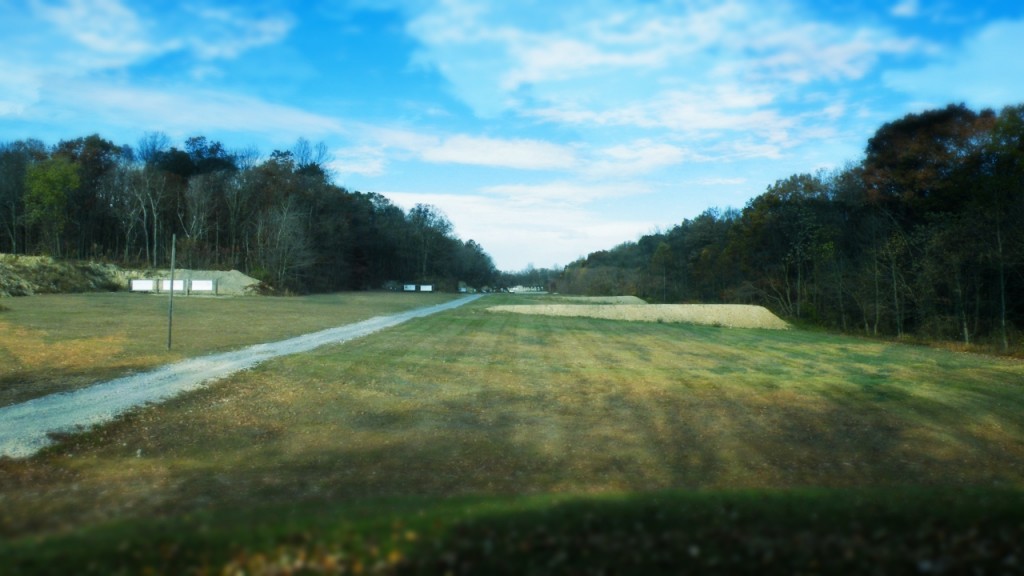
I would hate to make a call at 600 yards with a Mk1 Eyeball. BDC scopes, laser range finders, MIL DOTs, all help… some more than others.
Wrapping Up:
Marksmanship is constantly evolving. No longer do you have to be a crusty slung up rifleman making wind calls off the angular deflection off your beard and dialing up from your 300 meter drum based off the range estimate of the front sight post width. All tools and techniques have value, but which tools and techniques have MORE value and accelerate your capability? As marksmanship continues to evolve, it is up to us to follow the trends and study the data. Examine with a deep curiosity what techniques work and which don’t.
A well-rounded rifleman can handle any task from 0-800 (or more) yards depending on the rifle platform and caliber. Developing a pathway based on building foundational skills for the rifleman, analyzing statistical significance of different bullets and zero schemes as they relate to the target, and developing internal methods as well as utilizing external tools to estimate range, wind, and if applicable angle, all translate to a rifleman who can shoot to a devastating degree of accuracy. Each layer is a skill set that enhances the ability and range of a rifleman.





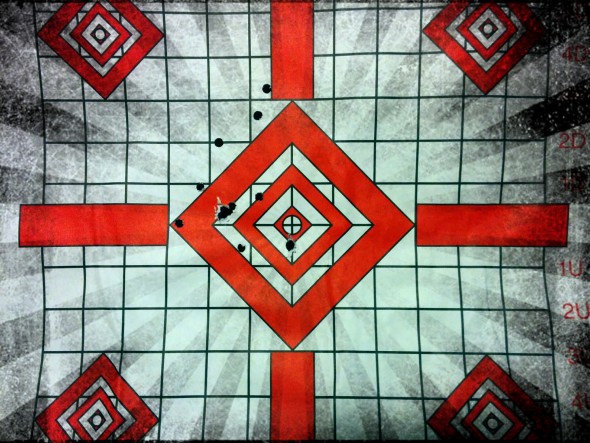



I recommend attending a Project Appleseed event. Why re-invent the wheel?
I would love to see the appleseed course. I would never turn down the opportunity to learn more… However, when you boil ballistics down to the science and art of hitting a target, I am looking for statistical gains on hit percentage.
Please google search and go to the Appleseed site. You can find shoots all over the United States and there is bound to be one close to you. There is one at the Wittington Center, in New Mexico, at the end of July. Perhaps we will meet there?
Great write up. I nodded my head a lot through your coverage of MPBR and got excited when I saw you bring up WEZ and litz’s work.
One bit of trouble I had is that you mentioned environment but did not cover the real beast that is environmental shooting. I live in NW Iowa and we have thick heavy prairie. I talk to a lot of shooters and hunters in the area at the range and they are laying out prone or at a bench placing shots. The reality is that in a few weeks the grass and wetlands will be over the height of most any standard bipod on the market. This leaves a handful of the 30″ class bipods, shoot sticks and tripods for making clean shots at any kind of range in a real capacity in 85-90% of the terrain anyone might engage at range. Otherwise they are dealing with urban or suburban environments which of course deal with a whole new environment of shooting obstacles.
When I lived in Alaska and Colorado the environment was a complete shift. Heavily wooded areas into plains became the norm and it was needed to understand grassland but also high angle engagement and use of dense vegetation and angular shooting positions. I think it is valuable for any shooter to figure out what kind of public shooting areas they have within a certain range that mimics an environment they reside in and take that opportunity to train and collect personal data there. Ranges are great for range work. If you live in a desert area the environment around may very closely mirror your range but you also may have new issues with range estimation and mirage control. I truly believe that environment is the single sticking point that separates some amazing marksmen from being viable riflemen.
As always great work and I enjoyed reading.
Thanks Nick. I am glad you brought it up, because you make some excellent points. Down in my neck of the woods, we have a dead season and a wet season. The coastal plains around by area are marked by flat shooting lanes juxtaposed between farmland and scrub brush / waist / chest height grass. Prone will mean very little in the wrong context, and getting up on a scrub brush tree will still be a very difficult proposition as the nature of the branches going down all the way to the ground means foliage will obscure much of my shooting off of trees.
In the dead season, the grass is still tall, but once I mow during drought the property will be clean for months… just dusty and cracked.
I will definitely reflect on your thoughts more about the environment and how important it is to incorporate into articles and goals. I don”t practice enough working around the grass!